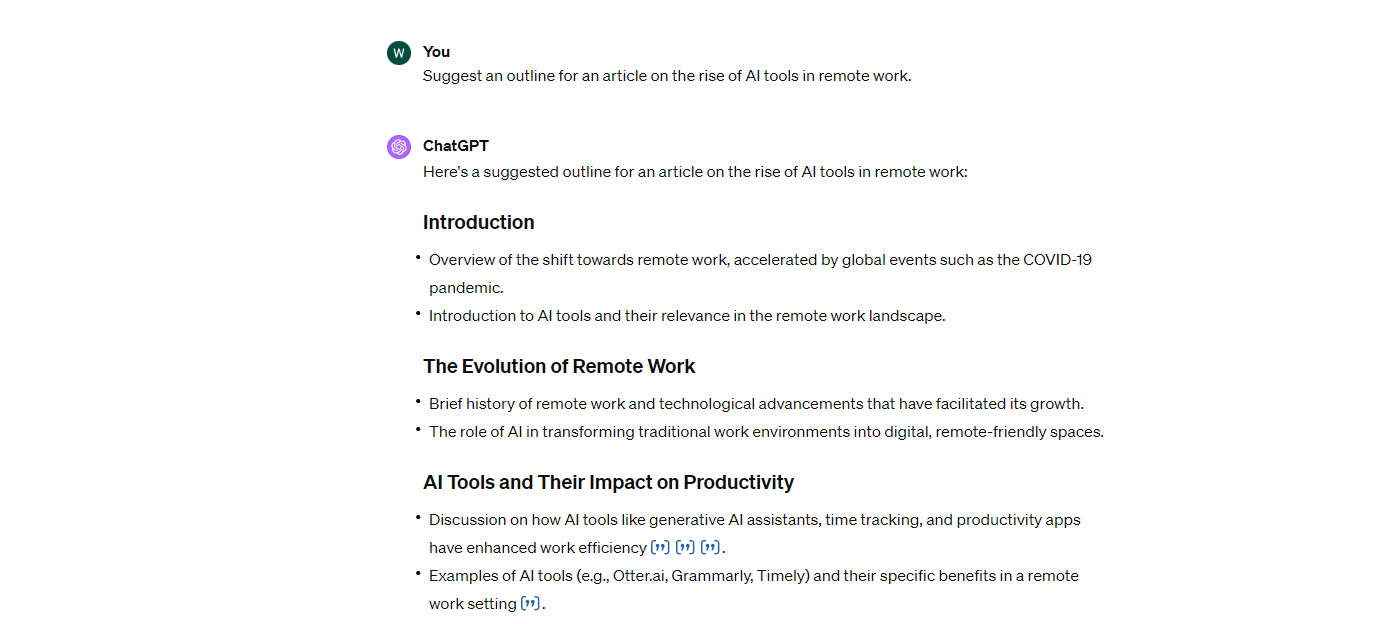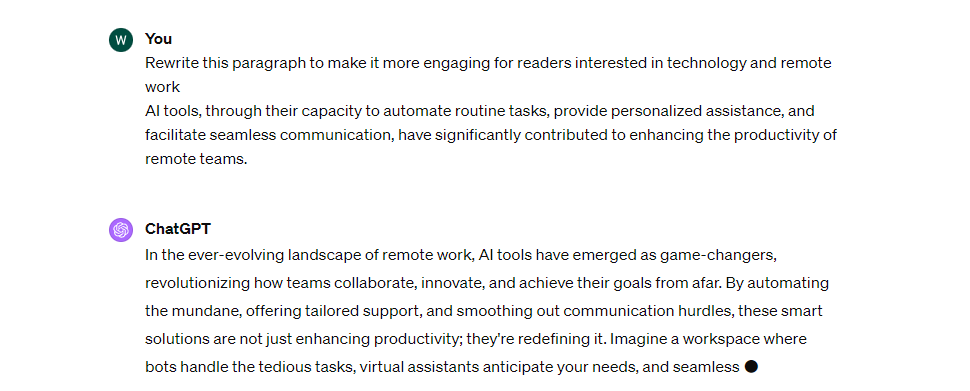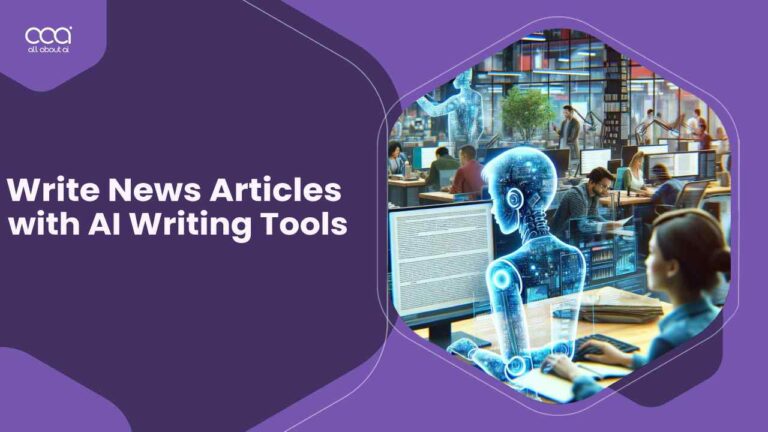In the rapidly evolving landscape of digital journalism, the integration of artificial intelligence (AI) writing tools has emerged as a groundbreaking development, offering new avenues for crafting compelling news articles.
As an expert in the field, I’ve mastered the art of how to write news articles with AI writing tools in Italy, a technique that has revolutionized the journalistic process by ensuring accuracy, efficiency, and creativity. This article aims to demystify the process of utilizing best AI writing tools in the world of news reporting.
From selecting the right tool to refining the final output, I will guide you through each step, illustrating how AI can be a powerful ally in your journalistic endeavors. By embracing AI and machine learning journalists, and content creators can not only keep pace with the demands of the digital age but also elevate the quality and relevance of their work.
Join me as we explore the transformative potential of AI in writing news articles, bridging the gap between traditional journalism and the technological frontier.
How to Write News Articles with AI Writing Tools in Italy – Step-by-Step Guide
In the journey of blending AI with the art of news writing, each step is pivotal. Here’s a detailed guide on how to write news articles with AI writing tools in Italy incorporating practical examples with an AI tool like ChatGPT, to craft news articles that stand out.
- Step 1: Choose a Topic
- Step 2: Conduct Preliminary Research
- Step 3: Define the Article’s Structure
- Step 4: Use the AI Tool to Generate a Draft
- Step 5: Edit and Revise the Draft
- Step 6: Add a Compelling Headline
- Step 7: Incorporate Multimedia Elements (if applicable)
- Step 8: Finalize the Article
- Step 9: Proofread and Fact-Check
- Step 10: Publish or Submit the Article
Step 1: Choose a Topic
The genesis of any compelling news article lies in selecting a relevant and engaging topic. It should resonate with your audience and reflect current trends or issues. For example, if you’re using ChatGPT, you could start by asking it to list current hot topics in your field of interest, such as “What are the trending topics in renewable energy today?” This approach ensures that your article is timely and appealing to readers.
Practical Example
Imagine you’re interested in writing about the impact of technology on remote work. You could ask ChatGPT: “What are the latest trends in technology affecting remote work?” Based on the AI’s response, you could narrow down your topic to something more specific, such as “The Rise of AI Tools in Enhancing Remote Work Productivity.

Step 2: Conduct Preliminary Research
Before diving into writing, it’s crucial to gather all necessary information about your chosen topic. This includes historical context, recent developments, and key figures involved. With ChatGPT, you can request a brief on the topic, like “Give me a summary of recent advancements in renewable energy.” This step ensures that you have a solid foundation of knowledge to build your article upon.
Practical Example
For the chosen topic, you would need background information and data. You could ask ChatGPT: “Provide me with a summary of recent studies on AI tools improving remote work productivity.” ChatGPT might then give you a brief overview, including key statistics and findings from various studies, which you can use to enrich your article.

Step 3: Define the Article’s Structure
A well-structured article guides the reader through your narrative seamlessly. Decide on the format (e.g., news report, feature story) and outline the main sections (introduction, body, conclusion). Ask ChatGPT to help organize your thoughts, for instance, “Suggest an outline for an article on renewable energy advancements.
Practical Example
Once you have your topic and some preliminary research, you’ll want to structure your article. You might say to ChatGPT: “Suggest an outline for an article on the rise of AI tools in remote work.” An example outline provided by ChatGPT could include an introduction to remote work, the evolution of AI tools, impacts on productivity, challenges and solutions, and a conclusion.

Step 4: Use the AI Tool to Generate a Draft
With your research and structure in place, it’s time to create a draft. Input your outline into ChatGPT, detailing each section’s focus, and let the AI generate a draft. For instance, “Write a draft section on the latest solar panel technology for my renewable energy article.” This process can significantly speed up writing time and provide a solid base to refine.
Practical Example
With your outline in hand, ask ChatGPT to flesh out each section. For instance: “Write a draft for the introduction section on the impact of AI tools on remote work productivity.” ChatGPT will generate a draft based on your request, which you can then review and refine.

Step 5: Edit and Revise the Draft
The first draft is rarely perfect. Review the AI-generated content for accuracy, tone, and engagement. Adjust the language to suit your audience and ensure that the article flows logically from one section to the next. You might say, “Help me rewrite this section to be more engaging to a general audience.”
Practical Example
After reviewing the draft, you might find a section that needs more engagement. You could ask ChatGPT: “Rewrite this paragraph to make it more engaging for readers interested in technology and remote work.” ChatGPT will offer a revised version that you can incorporate into your article.

Step 6: Add a Compelling Headline
Your headline is the first, and sometimes only, impression you make on potential readers. It should be captivating and informative. ChatGPT can generate headline suggestions based on your article’s content. Simply ask, “Generate five headline options for my renewable energy article.”
Practical Example
For a headline, you could ask ChatGPT: “Generate a compelling headline for an article about AI tools and remote work productivity.” ChatGPT might suggest something like “Empowering Remote Work: How AI Tools are Setting New Productivity Benchmarks.”

Step 7: Incorporate Multimedia Elements (if applicable)
Visuals can enhance your article’s appeal and comprehension. While ChatGPT itself doesn’t create multimedia, it can suggest types of images, videos, or infographics that would complement your article. For instance, “What type of images should I include in my renewable energy article?”
Practical Example
While ChatGPT can’t create multimedia, it can suggest ideas. Ask: “What type of images should accompany an article on AI tools for remote work?” ChatGPT might suggest images of people using AI for work, infographics on productivity improvements, or diagrams of AI tools in action.

Step 8: Finalize the Article
Integrate any multimedia elements and ensure your article is cohesive. This step is about refining the piece into its final form, ready for readers’ eyes. Use ChatGPT to help with transitions between sections or to summarize key points effectively.
Practical Example
To ensure cohesion, you might ask ChatGPT: “Help me create a smooth transition between the evolution of AI tools and their impact on productivity.” ChatGPT can then suggest transition sentences or paragraphs that help link sections naturally.
Step 9: Proofread and Fact-Check
Accuracy is paramount in journalism. Proofread your article for grammatical errors and fact-check all claims to ensure credibility. While ChatGPT can assist in suggesting sources for fact-checking, it’s crucial to verify information against reliable sources manually.
Step 10: Publish or Submit the Article
Once your article meets all criteria for quality and accuracy, it’s time to share it with the world. Whether you’re publishing on a digital platform or submitting to an editor, ensure your submission meets any required guidelines or formats.
The Rise of AI in Global Newsrooms
When understanding how to write news articles with AI writing tools in Italy it is also crucial to understand the integration of Artificial Intelligence (AI) tools marks a significant evolutionary leap, reshaping the creation and dissemination of news. This section explores the transformative journey of AI in journalism and its burgeoning role in newsrooms around the globe.

Evolution of AI Tools in Journalism:
- Early adoption of AI in journalism focused on automating routine tasks, such as data analysis and report generation, freeing journalists to engage in more in-depth investigative work.
- Advancements in natural language processing (NLP) and machine learning (ML) have enabled AI tools to not only generate news articles on financial reports and sports results but also assist in more complex journalistic endeavors like identifying trends and uncovering stories.
- The development of AI-driven analytics tools has provided journalists with insights into reader preferences and engagement, allowing for more targeted and relevant content creation.
Increasing Integration of AI in Newsrooms Globally:
- Globally, news organizations are increasingly leveraging AI to streamline operations, enhance content quality, and expand their reach. This includes automating the production of news summaries and curating personalized news feeds for readers.
- AI’s role in combating misinformation has become pivotal, with tools designed to verify facts and sources, thus maintaining the credibility and trustworthiness of news content.
- Collaborations between AI developers and newsrooms are fostering innovative applications, such as the use of drones for reporting and AI algorithms for predicting news trends, thereby setting new standards in journalism.
AI in News Article Creation – Case Studies and Insights
The deployment of AI in news article generation has been both groundbreaking and contentious, with several high-profile instances spotlighting the technology’s capabilities and challenges. This section delves into pivotal moments in AI journalism, such as the release of OpenAI’s GPT-2 and the WriteSonic incident, alongside the constructive use of tools like Chatsonic in content creation.
Controversies in AI Journalism:
The release of OpenAI’s GPT-2 model stirred significant debate due to its powerful text generation capabilities, raising concerns over the potential for generating misleading or false information at scale. This incident underscored the ethical considerations necessary in AI’s journalistic use.
The WriteSonic incident highlighted the challenges of ensuring accuracy and reliability in AI-generated content. A flaw in the algorithm led to the production of factually incorrect articles, sparking discussions on the importance of oversight and fact-checking in AI-assisted journalism.
Real-World Applications and Positive Outcomes:
Despite controversies, AI tools like Chatsonic have demonstrated substantial benefits in content creation, offering journalists and content creators efficient ways to generate articles, summaries, and even entire reports, thereby enhancing productivity and creativity.
AI’s role extends beyond mere content generation; it aids in data analysis, uncovering trends, and providing journalists with deep insights that inform more nuanced and comprehensive reporting.
The integration of AI in newsrooms has facilitated more personalized and engaging creative content for readers, adapting in real-time to user interests and behaviors, thus revolutionizing the reader experience.
The Transformative Benefits of AI in Journalism
The integration of AI into journalism heralds a new era of efficiency and breadth in news production. By automating routine tasks and analyzing vast datasets, AI technologies offer unprecedented advantages in streamlining operations and enhancing content creation. This section outlines the key benefits of AI in journalism, from accelerating production to expanding topic coverage and fostering impartial reporting.

Streamlining Operations Through Automation:
AI applications in newsrooms automate time-consuming tasks such as data collection and analysis, allowing journalists to focus on storytelling and investigative work.
The automation of content curation and distribution enables news organizations to efficiently meet the growing demand for timely and relevant news content.
Enhancing Production and Coverage:
AI-driven tools significantly reduce the time required to produce news articles, enabling faster response times to breaking news.
Advanced algorithms analyze reader preferences and trends, guiding newsrooms in covering a wider array of topics that resonate with their audience, thus expanding their reach and impact.
Reducing Bias and Enhancing Objectivity:
AI has the potential to identify and mitigate biases in news reporting by analyzing and comparing a vast range of sources and perspectives.
By utilizing data-driven insights, AI can help ensure a more balanced and fact-based approach to news writing, contributing to more informed and impartial public discourse.
Challenges and Solutions in AI-Driven Journalism
As AI becomes increasingly integrated into the journalism industry, it brings with it ethics that news organizations must navigate. Concerns surrounding accuracy, reliability, and bias in AI-generated content are at the forefront of the debate.
This section examines these challenges and the strategies employed to address them, ensuring responsible use of ai in news production which is also crucial to understand when learning about how to write news articles with AI writing tools in Italy:
Accuracy and Reliability Concerns:
The risk of generating factually incorrect or misleading information through AI necessitates robust verification processes to maintain the integrity of news content.
Continuous training of AI models on high-quality, verified datasets is crucial to improve the accuracy and reliability of output, mitigating the spread of misinformation.
Bias and Ethical Implications:
AI systems can inadvertently perpetuate biases present in their training data, leading to skewed or partial reporting that may not accurately reflect diverse perspectives.
Implementing bias detection and correction mechanisms within AI models is essential. This involves regular audits of AI algorithms for bias and the inclusion of diverse datasets to minimize partiality.
Mitigation Strategies:
Human oversight remains key in the editorial process, with journalists and editors playing a critical role in reviewing AI-generated content for accuracy, context, and fairness.
Developing ethical guidelines for AI use in journalism and conducting ongoing training for newsroom staff on these issues helps ensure that AI tools are used responsibly and in line with journalistic standards.
AI’s Expanding Role in the Future of Journalism
The future of journalism is being reshaped by the rapid advancement of AI technologies, as explored in how to write news articles with AI writing tools in Italy. This development promises a landscape where news is more personalized, accessible, and interactive than ever before.
As we look ahead, the evolving role of AI poses both opportunities and challenges, from transforming the job market to ensuring the preservation of journalistic integrity. This section explores the potential trajectories of AI in journalism, offering insights into its impact on content delivery, employment, and ethical reporting practices.

Personalized News Delivery and Interactive Content:
AI’s capacity for analyzing reader preferences and behaviors is set to revolutionize news delivery, offering highly personalized content that caters to individual interests and needs.
Emerging technologies such as AI-driven chatbots and virtual reality (VR) news experiences are enhancing audience engagement, making news consumption more interactive and immersive.
Impact on the Journalism Job Market:
While AI automates routine tasks, freeing journalists to focus on investigative and creative work, it also raises concerns about job displacement within traditional roles.
The demand for tech-savvy journalists and editors who can work alongside AI, leveraging its capabilities while adding human insight and value, is expected to grow, highlighting the need for new skills and training in the news industry.
Balancing AI Assistance with Journalistic Integrity:
The integration of AI in newsrooms necessitates a careful balance between leveraging technology for efficiency and maintaining the core values of journalism, including accuracy, fairness, and accountability.
Establishing clear guidelines and ethical standards for AI use in journalism is crucial to ensure that AI assists rather than undermines journalistic integrity, fostering trust and credibility in AI-generated content.
FAQs
Why is AI Writing Important in Journalism?
How is AI Writing Impacting the Job Market in Journalism?
How is AI used in reporting?
How many journalists use AI?
Conclusion:
That was it from my side on how to write news articles with AI writing tools in Italy the advent of AI in journalism marks a pivotal shift in how news is gathered, reported, and consumed. From automating mundane tasks to enabling personalized news delivery, AI has not only streamlined operations but also enriched content creation and expanded topic coverage.
the importance of maintaining a symbiotic relationship between AI and human journalists becomes clear. The future of journalism lies in leveraging AI to enhance, not replace, the human element of storytelling. This journey into the unknown is filled with opportunities for innovation and requires careful consideration of the ethical implications of AI in news reporting.
For further exploration, dive into our comprehensive resources including our AI glossary and how-to guides for implementing AI in Journalism, serving as a beacon for those navigating the ever-evolving landscape of digital journalism.





